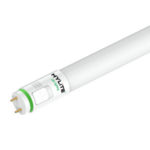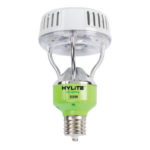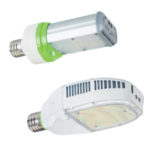Lighting Technologies
Light Emitting Diodes
Light Emitting Diodes (LEDs) are a solid-state lighting technology that is quickly gaining in popularity because of its high efficiency and long lamp life. LED lights have been developed for all types of applications to replace incandescent, fluorescent, and HID technologies.
How Light Emitting Diodes Work:
An LED is a semiconductor that emits visible light when an electrical current is applied. LED Chips are combined in a package that can include a heat sink, lens, and connections. These packages are combined in an LED Array which acts as the light source for LED lighting systems. LED lamps and luminaires combined LED arrays with a power supply, housing, electrical connections, and thermal controls.
LED Lamps and Luminaires offer a high lumen efficacy, good to excellent CRI, and long rated life. Additionally, LED lamps and luminaires can strike and restrike instantly, can be designed for dimming, and offer the widest range of color temperatures.
LED lamps and luminaires have been designed for all types of applications for both indoor and outdoor use. LED lighting has a wide range of operating characteristics because of the variety of types and quality of components available.
Incandescent:
The Incandescent lamp was the first commercialized lighting technology. Incandescent lamps are constructed with a wire filament inside a glass envelope. Top produce light, the filament is heated till visible light is emitted from the lamp. Incandescent technology is very inefficient compared to newer lighting technologies. Average lifespan is 1,000 to 2,000 hours. The lower upfront cost for incandescent technology is the primary advantage. This advantage is greatly offset by high energy and maintenance costs acquired by using the lamp. Additionally, Incandescent technology offers one of the highest CRIs at >95.
Halogen Lamps are a type of incandescent technology that utilizes halogen gas to increase the efficacy and lamp life of the bulb. The halogen gas inside the lamp reacts with the evaporated filament and recycles it back to the filament.
Incandescent and Halogen lamps are available in a wide range of forms including A-line, PAR, BR, R, Candelabra, and Globe shaped lamps.
Fluorescent:
Fluorescent lighting technology is one of the most popular and frequently used technologies. They are used in commercial, industrial, and residential lighting applications.
How Fluorescent lamps works:
Fluorescent lighting is categorized as a low-pressure gas discharge lamp. Fluorescent lamps pass an electric arc through mercury vapor. This process generates ultraviolet light within the tube. As the UV light passes outside the tube, the phosphor coating on the inside of the tube converts the UV light to visible light. Different combinations of phosphors dictate the color temperature of the visible light. Fluorescent lamps require a ballast to provide the appropriate operating current. Ballast can be an external device or integrated into the lamp.
Types of Fluorescent Lamps:
Fluorescent lamps can be found in a variety of sizes and shapes. Fluorescent lamps can be categorized in two main categories: Linear and Compact Fluorescent (CFL).
Linear Fluorescent Lamps: are available in various lengths. Linear fluorescent lamps are identified by a number indicating the eighths of an inch in diameter of the tube. For example, a T8 lamp is 8/8 inch (or 1 inch) in diameter. In general, thinner tubes are more efficient. All linear fluorescent lamps operate with an external ballast. There are three common types of LFLs: T12 & T8
Compact Fluorescent Lamps: Also known as CFLs, come in screw-in and pin based models. Screw-in based CFLs have integrated drivers and are designed to install in existing Edison bases. Plug-in CFLs install in conjunction with an external ballast. To prevent installing the wrong size or type of lamp with a plug-in CFL, many different lamp bases have been created. More information on types of lamp bases and sockets can be found here.
High-Intensity Discharge Lamp:
High-Intensity Discharge (HID) lamps are commonly used for general area lighting including high bay, parking lot, and flood lighting. The most common types of high-intensity discharge lamps are metal halide and high-pressure sodium.
How HID Lamps Work:
High-Intensity Discharge lamps create light by means of an electrical arc. The arc tube is contained in a tube that includes metals which emit visible light when evaporated by the electrical arc. HID lamps require a ballast to provide the optimal current for operation. The ballast consumes additional energy on top of the rated wattage of the lamp. HID ballast typically consume 5 to 15% of the rated wattage of the lamp.
HID lamps are most commonly found with E26, E39, and Ex39 bases. Watts can range from 35W to 1500W.
To start, HID lamp requires a warm-up period to reach full brightness. Warm up can take anywhere from 3 to 5 minutes depending on the type of lamp. HID lamps need to cool to a certain temperature before restrike can occur. For this reason, restrike takes between 5 to 15 minutes.
Types of HID Lamps:
Metal Halide Lamps: Metal Halide (MH) lamps are utilized in a wide variety of applications. Metal Halide lamps feature a relatively high CRI compared to high-pressure sodium and feature a more adaptable color temperature. CCT ranges from 3500K to 4200K. This makes metal halide lamps an appealing choice for both indoor and outdoor lighting applications.
High-Pressure Sodium Lamps: High-Pressure Sodium (HPS) lamps provide illumination with a distinctly warm color temperature (2000K to 2200 K). This color temperature can be more appealing for residential street and area lighting than metal halide lamps but is not good for indoor lighting. HPS lamps efficacy ranges widely from 80 to 140 lumens per watt. HPS lamps have a poor CRI.







